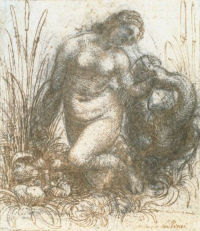
- Enlarge
- © Museum Boijmans Van Beuningen, Rotterdam
Study for the kneeling Leda c1506-08
Leonardo’s intense study of nature equipped him for the imaginative exploration of pictorial themes based on concepts developed from his imagination.
In this drawing of the mythical “Leda and the Swan”, he expresses his feeling for the generative powers of nature.
According to the legend, Leda, the wife of Tyndareus, King of Sparta, was seduced by Jupiter in the form of a swan and bore two eggs, from which hatched Helen of Troy with Clytemnestra, and Castor with Pollux. Leda’s fruitful liaison with the swan symbolized the union of man and nature.
In this drawing the fecundity of their union is underlined by the children, just hatched from their eggs, and the flowering and seeding plants that surround both Leda and the swan. Leda turns her face to the swan, chastely caressing it with her left hand.
Leonardo articulates the voluptuous forms of her figure with curving, hatched lines that round out her body in three-dimensions. Spiralling forms predominate throughout the drawing, in the shape of the plants, children and in the forms of Leda and the swan, providing a dynamic sense of energy and movement in the drawing.
Leonardo explores the relationship between Leda and the swan particularly through the position of the swan’s head and neck, which have been redrawn several times in charcoal or soft black chalk before finally being fixed in pen and ink.
- Medium Pen and ink over black chalk
- Size 12.5 x 11 cm
- Location Museum Boijmans Van Beuningen

